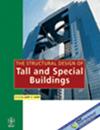每排四个螺栓的十字形短柱的拉伸性能
IF 1.3
3区 工程技术
Q3 CONSTRUCTION & BUILDING TECHNOLOGY
引用次数: 1
摘要
加筋顶部和底部角钢连接在地震多发地区广泛使用,在角钢柱腿上增加受拉螺栓可有效改善其弯曲性能。然而,此类设计和施工不受任何法规的约束。迫切需要弄清楚其力学行为,并开发准确的理论方法。基于构件法,本文首先对提取的每排四个螺栓的十字形短柱进行了实验研究。它比较了不同厚度的拉伸性能和损伤模式。之后,进一步的参数分析比较了短柱厚度、螺栓布置以及验证后螺栓是否预紧的影响。观察到短柱厚度和螺栓规格对塑性阻力的影响大于螺栓距离。此外,通过对经典加肋角和非加肋角的综合方法,提出了一个每排四个螺栓的十字形短柱塑性阻力预测模型。本文章由计算机程序翻译,如有差异,请以英文原文为准。
Tensile behavior of cruciform stubs with four bolts per row
The stiffened top‐and‐seat angle connection is widely used in earthquake‐prone areas, and additional tensile bolts on angles' column leg effectively improve its bending behavior. However, such design and construction are not governed by any regulations. It is urgent to figure out the mechanical behavior and develop accurate theoretical methods. Based on the component method, this paper first conducted an experimental study on the extracted cruciform stubs with four bolts per row. It compared the tensile properties and damage modes for different thicknesses. After that, the further parametric analysis compared the impact of stub thickness, bolt arrangement, and whether or not the bolt was pretensioned after validation. Stub thickness and bolt gauge were observed with a greater impact than the bolt distance on the plastic resistance. Furthermore, a prediction model for the plastic resistance of the cruciform stub with four bolts per row is proposed by integrating approaches for classic stiffened and unstiffened angles.
求助全文
通过发布文献求助,成功后即可免费获取论文全文。
去求助
来源期刊
CiteScore
5.30
自引率
4.20%
发文量
83
审稿时长
6-12 weeks
期刊介绍:
The Structural Design of Tall and Special Buildings provides structural engineers and contractors with a detailed written presentation of innovative structural engineering and construction practices for tall and special buildings. It also presents applied research on new materials or analysis methods that can directly benefit structural engineers involved in the design of tall and special buildings. The editor''s policy is to maintain a reasonable balance between papers from design engineers and from research workers so that the Journal will be useful to both groups. The problems in this field and their solutions are international in character and require a knowledge of several traditional disciplines and the Journal will reflect this.
The main subject of the Journal is the structural design and construction of tall and special buildings. The basic definition of a tall building, in the context of the Journal audience, is a structure that is equal to or greater than 50 meters (165 feet) in height, or 14 stories or greater. A special building is one with unique architectural or structural characteristics.
However, manuscripts dealing with chimneys, water towers, silos, cooling towers, and pools will generally not be considered for review. The journal will present papers on new innovative structural systems, materials and methods of analysis.

 求助内容:
求助内容: 应助结果提醒方式:
应助结果提醒方式:


